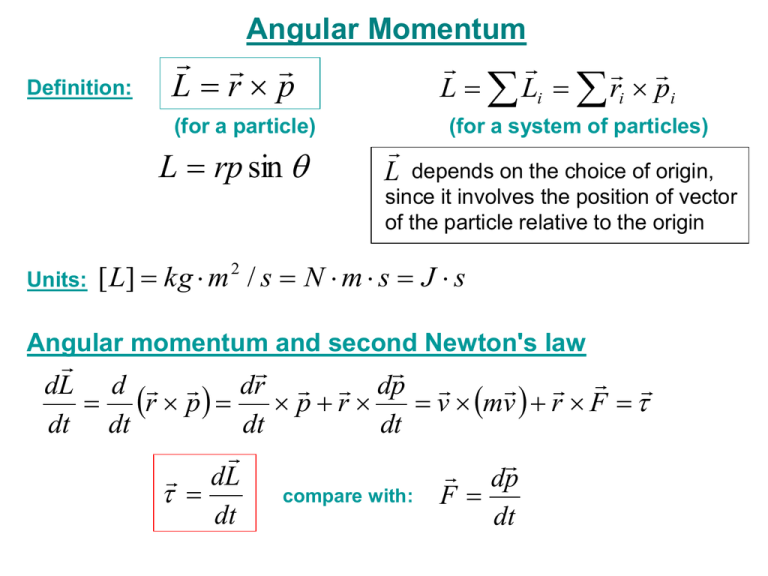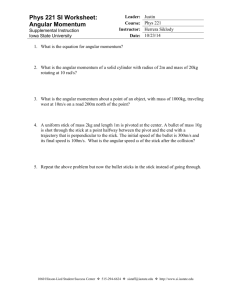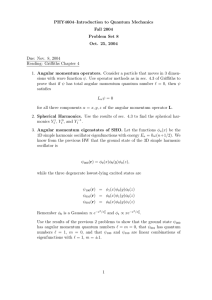p r
advertisement

Angular Momentum Definition: Lrp (for a particle) L rp sin Units: L Li ri pi L (for a system of particles) depends on the choice of origin, since it involves the position of vector of the particle relative to the origin [ L] kg m 2 / s N m s J s Angular momentum and second Newton's law dL d dr dp r p pr v mv r F dt dt dt dt dL dp compare with: F dt dt Conservation of angular momentum FAB FBA FAB r AB sin ABr BAsin BA rF sin r F dL A dLB AB BA AB BA 0 dt If ext rAB FBA rBA r sin dt dL 0 0 Li L f dt When the external torque acting on a system is zero, the total angular momentum is conserved compare with conservation of linear momentum Angular momentum for a rigid body rotation around a symmetry axis z L1 r1 L Rp sin Rp Rmv Rmr L x1 L x 2 0 L2 r2 L z1 L z 2 L sin Rmr sin mr 2 L L z Liz mi ri 2 I R1 R 2 L I L I L z I z Kinetic energy: K rot 2 L 12 I 2I 2 Conservation of angular momentum for a rigid body rotation around a symmetry axis If ext 0 ext dL dI I dt dt I ii I f f Noether’s Theorem So far we have learned about three conserved quantities Energy Momentum Angular Momentum Conserved quantities are precious in theoretical physics because… According to Noether’s Theorem, for each conserved there exists a symmetry of the laws of physics which “generates” it. Emmy Amalie Noether 1882-1935 Example: A person of mass 75 kg stands at the center of a rotating marry-go-round platform of radius 2.0 m and moment of inertia 900 kgm2. The platform rotates without friction with angular velocity 2.0 rad/s. The person walks radially to the edge of the platform. Calculate the angular velocity when the person reaches the edge. m = 75 kg r = 2.0 m Ip = 900 kgm2 ω1 = 2.0 rad/s ω2 - ? L I I1 = Ip I2 = Ip + mr2 Ip ω1 = (Ip + mr2 )ω2 L1 = L2 2 I Ip p mr 2 1 900kg m 2 900 2 2.0rad / s 2.0rad / s 1.5rad / s 2 2 1200 900kg m 75kg 2.0m Example: A uniform stick of mass M and length D is pivoted at the center. A bullet of mass m is shot through the stick at a point halfway between the pivot and the end. The initial speed of the bullet is v1 and its final speed is v2. What is the angular speed ω of the stick after the collision? External forces: weight of the stick and force on the stick by the pivoting axle produce no torque. Weight of the bullet is negligible. No external torque → Angular momentum conserved D D mv1 mv2 I z 4 4 D Lz before mv1 4 D Lz after mv2 I z 4 v1 D z I 1 12 D/4 MD 2 mD v2 v1 4I 3m v2 v1 M D ω v2 Example: What if instead of a stick we have a thicker block so the bullet embeds itself in it? Lz Lz before after D mv1 4 v D 4 z 2 2 D D D mv I z m z I z m I z 4 4 4 D 12m v1 4 z 1 1 mD 2 MD 2 3m 4M D 16 12 mv1 Total linear momentum ptotal is not conserved, because Fnet,ext 0 v1 ω’ D D/4 Example: A student sits on a rotating stool and holds a rotating horizontal bicycle wheel by a rod through its axis. The stool is initially at rest. The student flips the axis of rotation of the wheel by 180°. What happens to the stool? A. It rotates in the same direction as the wheel after the flip. B. It rotates in the same direction as the wheel before the flip C. Nothing! Why would it rotate at all? Lw Ltotal Ls+ s Lw Example: A force is applied to a dumbbell for a certain period of time, first as in (a) and then as in (b). In which case does the dumbbell acquire the greater center-of-mass speed? 1) case (a) 2) case (b) 3) no difference 4) It depends on the rotational inertia of the dumbbell. In which case does the dumbbell acquire the greater energy? Example: A spherical shell rotates about an axis through its center of mass. It has an initial radius Ri and angular speed ωi. By applying a radial force, we can cause the sphere to collapse to Rf = Ri/3. What is the ratio of the final and the initial angular speed, ωf/ωi ? Li Iii Lf I ff Iii I ff f Ii MRi 2 Ri 2 2 9 2 i If MRf Rf





